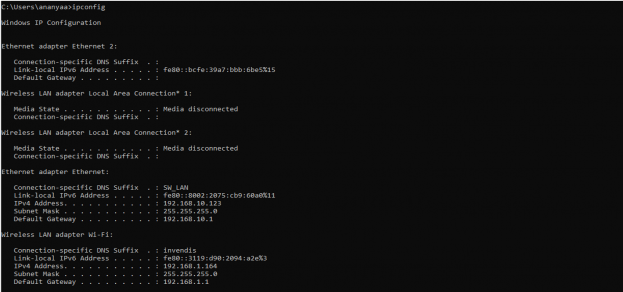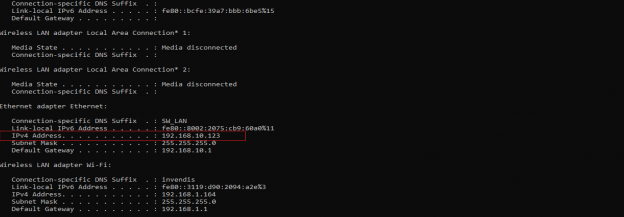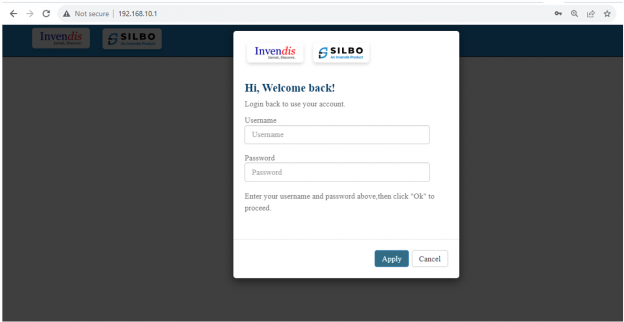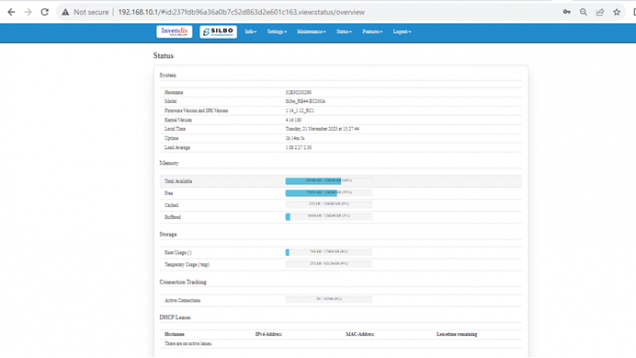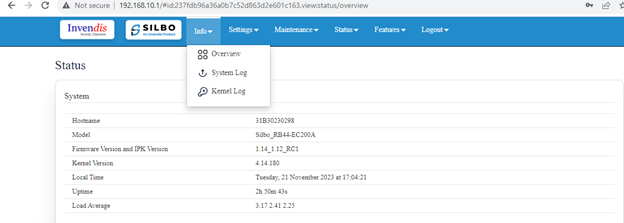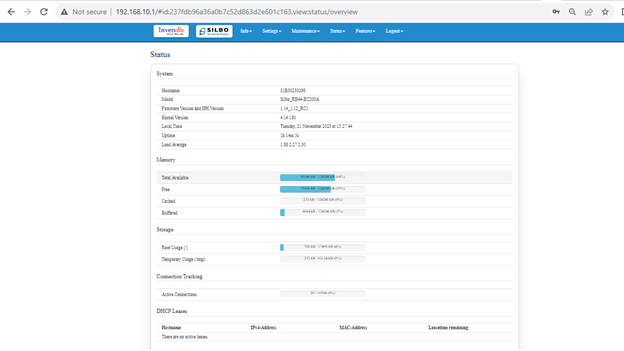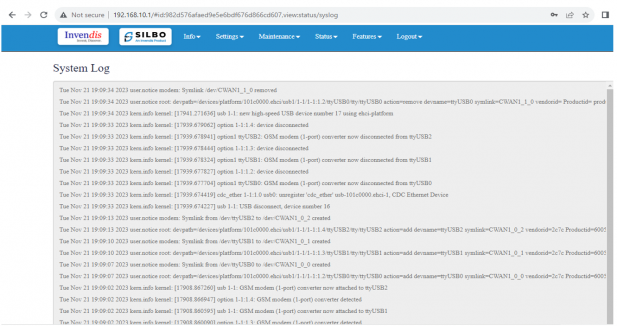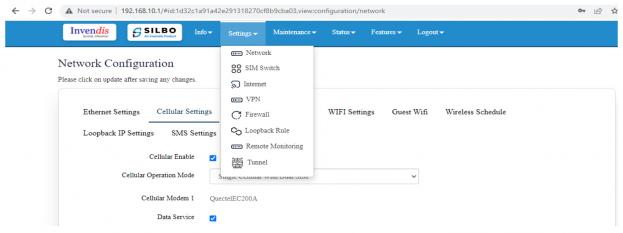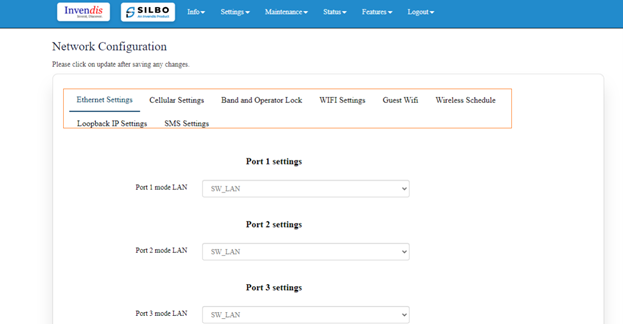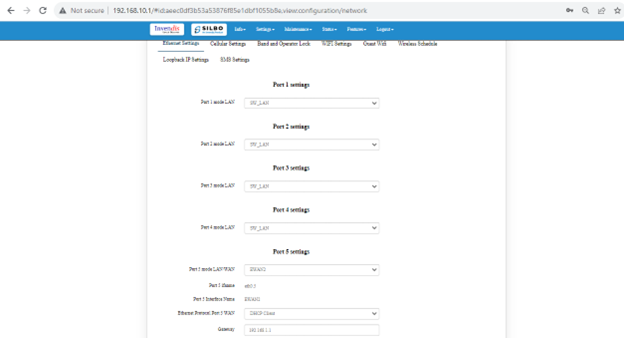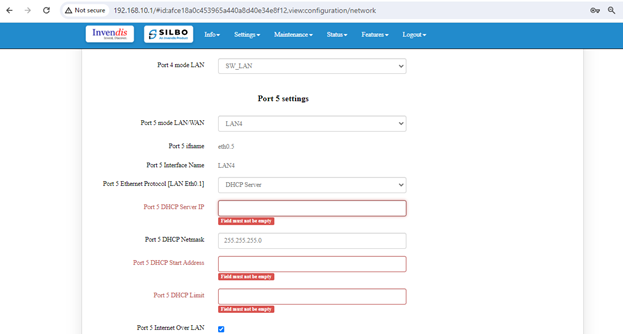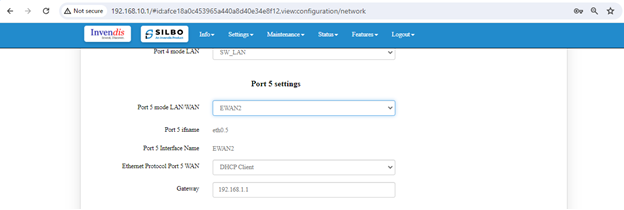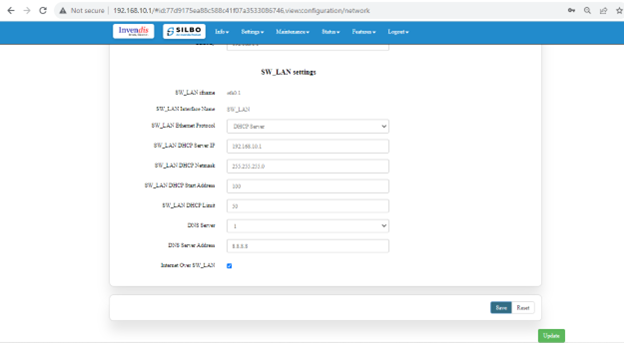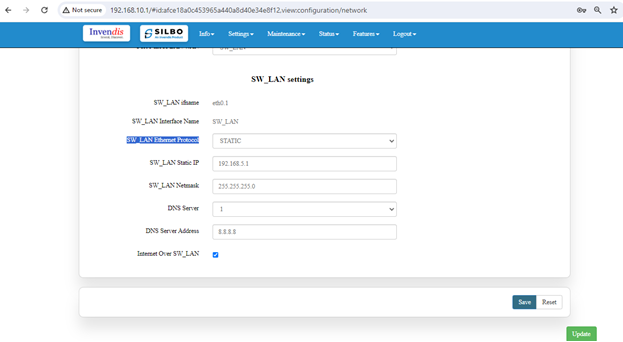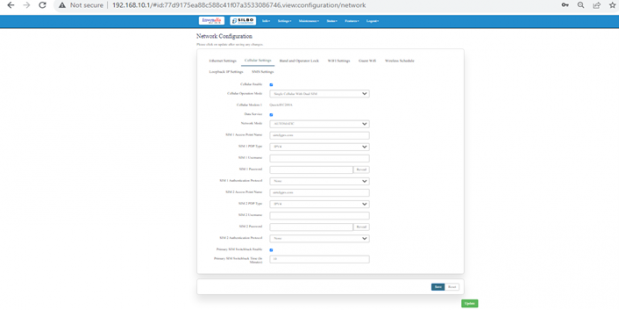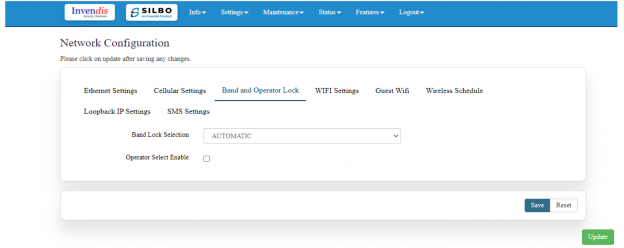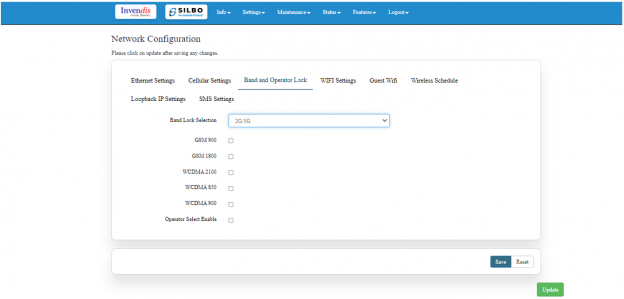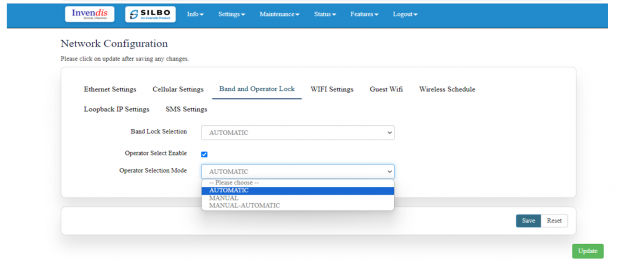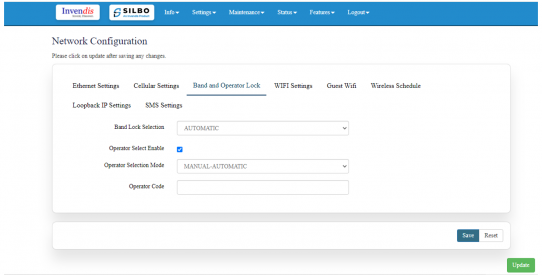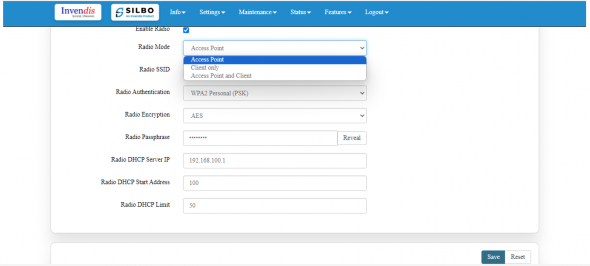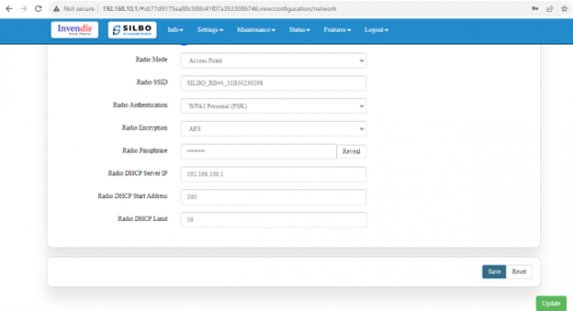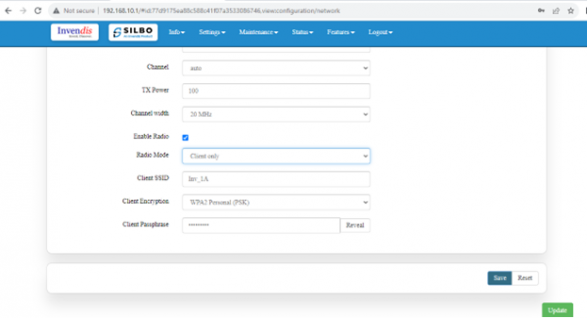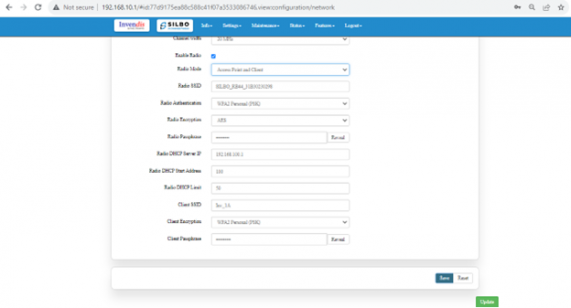RB44 Manual: Difference between revisions
(→SIM) |
(→SIM) |
||
| Line 628: | Line 628: | ||
'''Client point:''' In client mode, the access point connects your wired devices to a wireless network. This mode is suitable when you have a wired device with an Ethernet port and no wireless capability, for example, a smart TV, Media Player, or Game console and you want to connect it to the internet wirelessly, select the Client Mode and give the Radio SSID & client passphrase | '''Client point:''' In client mode, the access point connects your wired devices to a wireless network. This mode is suitable when you have a wired device with an Ethernet port and no wireless capability, for example, a smart TV, Media Player, or Game console and you want to connect it to the internet wirelessly, select the Client Mode and give the Radio SSID & client passphrase | ||
[[File:Client point.png|frameless|587x587px]] | |||
'''Access point and client point''': select this option for both type connection, give both SSID and passphrase. | |||
[[File:Access point and client point.png|frameless|571x571px]] | |||
After configuring all the required information, the user should click on the save and then click on the update to update the all the required information. | |||
{| class="wikitable" | |||
|SN | |||
|Field name | |||
|Sample value | |||
|Description | |||
|- | |||
|1 | |||
|Radio 0 Protocol | |||
|IEEE 802.11 b/g/n | |||
|In this dropdown the user should select which protocol is being used | |||
|- | |||
|2 | |||
|Country Code | |||
|INDIA | |||
|In this dropdown the user should select which county it belongs to . | |||
|- | |||
|3 | |||
|Channel | |||
|Auto | |||
|In this dropdown the user should select the proper channel to be used . | |||
|- | |||
|4 | |||
|TX Power | |||
|100 | |||
|In this text box the user should specify the power. | |||
|- | |||
|5 | |||
|Channel Width | |||
|20 MHz | |||
|In this dropdown the user should select the channel width | |||
|- | |||
|6 | |||
|Radio Mode | |||
|Access point | |||
|In this drop down the user should select the mode . | |||
|- | |||
|7 | |||
|Radio SSID | |||
|SILBO_RB44_31B30230298 | |||
|In this text box the user should specify the SSID number | |||
|- | |||
|8 | |||
|Radio Authentication | |||
|WPA2 Personal (PSK) | |||
|In this dropdown the user should select the type of authentication. | |||
|- | |||
|9 | |||
|Radio Encryption | |||
|AES | |||
|In this dropdown the user should select the type of encryption required. | |||
|- | |||
|10 | |||
|Radio Passphrase | |||
| | |||
|In this text box the user should specify the password. | |||
|- | |||
|11 | |||
|Radio DHCP server IP | |||
|192.168.100.1 | |||
|In this text box the user should specify the IP address of DHCP server. | |||
|- | |||
|12 | |||
|Radio DHCP start address | |||
|100 | |||
|In this text box the user should specify the start address of the DHCP. | |||
|- | |||
|13 | |||
|Radio DHCP limit | |||
|50 | |||
|In this text box the user should specify the limit for the DHCP. | |||
|} | |||
Revision as of 12:58, 27 June 2024
This page contains the user manual for RB44.
Connecting with the device to the System (Laptop/Desktop).
To log in to SILBO_RB44 by connecting the router to your laptop or desktop via LAN or using Wi-Fi, please follow the steps below.
Connecting via LAN:
Connect your laptop's LAN port to one of the router's LAN interfaces. Ensure that you select any LAN interface (there are two available) while making sure the WAN interface is not used.
How to connect with the SILBO_RB44 application
Once the LAN connection is established between the device and the laptop or the desktop
Please open the command prompt and ping go get the ip config of that device.
Type the command Ipconfig
It will provide the Ip address/url of that device through which the application can be accessed.
Log In
Open the web browser and type the IP address in the URL.
It will show the log in page of the application.
Give the valid credentials for the username and password to login to the application page.
Once the user credentials are provided it will direct to the landing page of the application.
The “Status” landing page shows all the detailed specification of the device like system, memory storage and connection tracking etc.
The application is divided in to 6 Modules.
- Info
- Settings
- Maintenance
- Status
- Features
- Logout
1.Info
The “Info” module provides the information about the devices to the user.
It provides all the specification related to the hardware, firmware, Networks and the Connection uptimes.
It has 3 submodules.
- Overview
- System Log
- Kernel Log
1.1 Overview
In overview module it displays all the specification categorically of a device like System, Memory, storage, Connection tracking, DHCP Lease.
System
In this section it displays the hardware configured specification of the device.
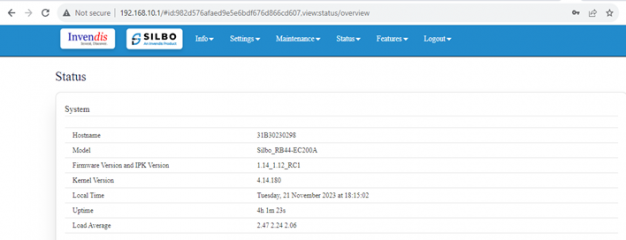
The specifications details are as follows,
| SN | Field name | Sample value | Description |
|---|---|---|---|
| 1 | Hostname | 31B30230298 | This field displays the router serial number of the device |
| 2 | Model | 31B30230298 | This field displays the model number of the device |
| 3 | Firmware Version and IPK Version | 1.14_1.12_RC1 | This field displays the firmware version and IPK version |
| 4 | Kernel Version | 4.14.180 | This field displays the kernel version of the device |
| 5 | Local Time | Tuesday, 21 November 2023 at 18:22:41 | This field displays the local time |
| 6 | Uptime | 4h 9m 19s | This field displays the uptime of the device |
| 7 | Load Average | 2.32 2.14 2.10 | This field displays the average load |
Memory
In this section it displays the memory configured specification of the device.

The specifications details are as follows.
| SN | Field name | Sample value | Description |
| 1 | Total Available | 77928 kB / 124248 kB (62%) | This field displays the total availability of memory space in the device |
| 2 | Free | 72436 kB / 124248 kB (58%) | This field displays the Free memory space in the device |
| 3 | Cached | 240 kB / 124248 kB (0%) | This field displays the Cached memory space in the device |
| 4 | Buffered | 6684 kB / 124248 kB (5%) | This field displays the Buffered memory space in the device |
Storage
In this section it displays the status of storage as root and temporary usage specification of the device.
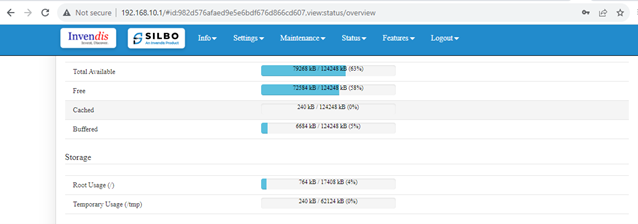
The specifications details are as follows.
| SN | Field name | Sample value | Description |
| 1 | Root Usage |
|
This field displays the total root usage of the device |
| 2 | Temporary Usage |
240 kB / 62124 kB (0%) |
This field displays the total temporary usage of the device |
Connection Tracking
In this section it displays the status of connection tracking for the device.
![]()
The specifications details are as follows.
| SN | Field name | Sample value | Description |
| 1 | Active Connection |
79 / 16384 (0%) |
This field displays the active connection of the device. |
DHCP Leases
In this section, it displays the DHCP lease of the temporary assignment of an IP address to a device on the network.
The specifications details are as follows.
| SN | Field name | Sample value | Description |
| 1 | Host Name | AnanyaA-LT | This field displays the configured Host Name/User Name for that device. |
| 2 | IPv4-Address | 192.168.10.123 | This field displays the IP address of the device. |
| 3 | MAC-Address | X:X:X:85:13:91 | This field displays the MAC-Address of the device. |
| 4 | Lease time remaining | 10h 4m 34s | This field displays the lease time remaining for the device. |
1.2 System Log
This page provides on screen System logging information.
In this page the user gets to view the system logs
1.3 Kernel Log
This page provides on-screen Kernel logging information.
In this page, the user gets to view the Kernel logs
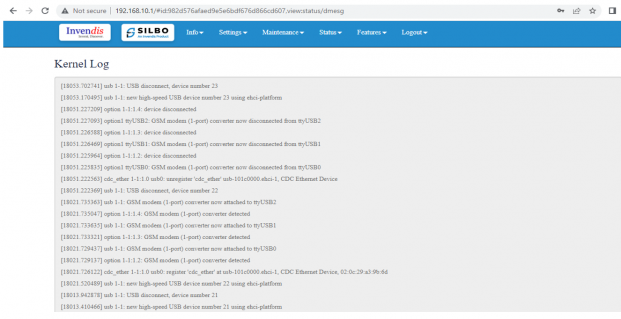
2. Setting
In this “Setting” module the user can Configure/update all the required parameters related to Network, SIM Switch, Internet, VPN, Firewall, Loopback Rule, Remote monitoring, Tunnel as per requirement.
IT consist of 8 submodules.
- Network
- Sim Switch
- Internet
- VPN
- Firewall
- Loopback Rule
- Remote Monitoring
- Tunnel
2.1 Network
In this section the user does all the setting related configuration with reference to network like Ethernet Setting, Cellular Setting, Band lock and Operator Lock, Wi-Fi, Guest Wi-Fi, Wireless Schedule, SMS Setting, Loopback IP.
Ethernet Setting
In this page it will display all the configured port that is attached with the device.
For this device 5 ports are configured. Ethernet mode can be configured as WAN and as LAN as well. Ethernet LAN Connection settings can be configured as DHCP server or Static.
For port 5 setting
Kindly select the option LAN4 for Port 5 mode LAN/WAN. Based on the option selected the filed will also changes the user needs to configure all the required field and click on the save to save the required fields.
| SN | Field name | Sample value | Description |
| 1 | Port 5 mode LAN/WAN | LAN4 | This field displays the port mode selection |
| 2 | Port 5 ifname | eth0.5 | This field displays the ifname. |
| 3 | Port 5 Ethernet Protocol [LAN Eth0.1] | DHCP Server | This field displays the Ethernet mode selection |
| 4 | Port 5 DHCP Server IP | 192.168.10.1 | This field displays DHCP server IP configured. |
| 5 | Port 5 DHCP Netmask | 255.255.255.0 | This field displays DHCP server Netmask address configured |
| 6 | Port 5 DHCP Start Address | 100 | This field displays DHCP server start address configured |
| 7 | Port 5 DHCP Limit | 50 | This field displays DHCP server limit |
Kindly select the option EWAN2 for Port 5 mode LAN/WAN. Based on the option selected the filed will also changes the user needs to configure all the required field and click on the save to save the required fields.
| SN | Field name | Sample value | Description |
| 1 | Port 5 mode LAN/WAN | EWAN2 | This field displays the port mode selection |
| 2 | Port 5 ifname | eth0.5 | This field displays the ifname. |
| 3 | Port 5 Interface Name | EWAN2 | This field displays the Ethernet mode selection |
| 4 | Ethernet Protocol Port 5 WAN | DHCP client | This field displays the client |
| 5 | Gateway | 192.168.1.1 | This field displays gateway address configured |
Click on the save once all the configuration is done and click on the update button to update all the information.
SW_LAN settings
In this part the user can configure the setting for SW_LAN
| SN | Field name | Sample value | Description |
| 1 | SW_LAN ifname | eth0.1 | This field displays the ifname. |
| 2 | SW_LAN Interface Name | SW_LAN | This field displays the interface name. |
| 3 | SW_LAN Ethernet Protocol | DHCP Server | This field displays the Ethernet mode selection |
| 4 | SW_LAN DHCP Server IP | 192.168.10.1 | This field displays DHCP server IP configured. |
| 5 | SW_LAN DHCP Netmask | 255.255.255.0 | This field displays DHCP server Netmask address configured |
| 6 | SW_LAN DHCP Start Address | 100 | This field displays DHCP server start address configured |
| 7 | SW_LAN DHCP Limit | 50 | This field displays DHCP server limit |
| 8 | DNS Server | 1 | This filed display number of DSN server availability |
| 9 | DNS Server Address | 8.8.8.8 | This filed display the DSN server address. |
After configuring all the required information, the user should click on the save and then click on the update to update the all the required information.
Static option for SW_LAN Ethernet Protocol
Select the option of static from the drop-down menu for SW_LAN Ethernet Protocol.
| SN | Field name | Sample value | Description |
| 1 | SW_LAN ifname | eth0.1 | This field displays the ifname. |
| 2 | SW_LAN Interface Name | SW_LAN | This field displays the interface name. |
| 3 | SW_LAN Ethernet Protocol | Static | This field displays the Ethernet mode selection |
| 4 | SW_LAN static IP | 192.168.5.1 | This field displays static server IP configured. |
| 5 | SW_LAN Netmask | 255.255.255.0 | This field displays static server Netmask address configured |
| 6 | DNS Server | 1 | This filed display number of DSN server availability |
| 7 | DSN Server Address | 8.8.8.8 | This filed display the DSN server address. |
After configuring all the required information, the user should click on the save and then click on the update to update the all the required information.
Cellular Setting
In this page, the user needs to configure the various details with respect to the SIM.
select single cellular single sim where the user must configure the APN details of the sim used for the router device. The Configurations can be done based on the SIM usage, with respect to IPV4 or IPV.
| SN | Field name | Sample value | Description |
| 1 | Cellular Operation Mode | Single Cellular with Dual Sim | This field displays the cellular operation mode. |
| 2 | Cellular Modem 1 | QuectelEC200A | This field displays the modem name. |
| 3 | Network Mode | Automatic | This field displays the Network mode selection |
| 4 | SIM 1 Access Point Name | airtelgprs.com | This field displays the name of the Sim 1 access point configured. |
| 5 | SIM 1 PDP Type | IPV4 | This field displays the type of SIM 1 |
| 6 | SIM 1 Username | This field is optional, and the user can configure the name of the SIM 1 | |
| 7 | SIM 1 Password | This field is optional, and the user can configure the password for the SIM 1 | |
| 8 | SIM 1 Authentication Protocol | None | This field displays the type of protocol is being used for SIM 1 |
| 9 | SIM 2 Access Point Name | airtelgprs.com | This field displays the name of the Sim 2 access point configured. |
| 10 | SIM 2 PDP Type | IPV4 | This field displays the type of SIM 2 |
| 11 | SIM 2 Username | This field is optional, and the user can configure the name of the SIM 2 | |
| 12 | SIM 2 Password | This field is optional, and the user can configure the password for the SIM 2 | |
| 13 | SIM 2 Authentication Protocol | None | This field displays the type of protocol is being used for SIM 2 |
| 14 | Primary SIM Switchback Time (In Minutes) | 10 | This field displays the time given for sim to swich in between. |
After configuring all the required information, the user should click on the save and then click on the update to update the all the required information.
Band lock and Operator Lock
In this page, the user needs to configure the lock band and operator based on the service provider.
Bands available in the drop-down list.
2G/3G option
2G/3G: - 3G allows additional features such as mobile internet access, video calls and mobile TV. While the main function of 2G technology is the transmission of information through voice calls.
The user should select the band check box available for 2g/3g from the given list.
Bands available for selection under LTE for the bands available that zone.
Operator Selection Mode
The user needs to click on the check box of the “operator select enable” to select the operator.
Once the check box is clicked there will be a dropdown list of the operator modes from which the user needs to select the mode. The user needs to select the operator mode from the given dropdown list.
If the user selects the mode “Manual” or “Manual-Automatic” then one more text box will appear where the user must provide the operator code.
After configuring all the required information, the user should click on the save and then click on the update to update the all the required information.
Wi-Fi Setting
Wi-Fi is a family of wireless network protocols based on the IEEE 802.11 family of standards, which are commonly used for local area network of devices and internet access, allowing nearby digital devices to exchanges data by radio waves. These are the most widely used computer network, used globally in home and small office networks to link devices and to provided internet access with wireless router and wireless access point in public places. In this router has the general setting and change country code, channel, radio mode, radio passphrase as per the requirement after clicking on enable Radio button.
The user needs to select the respective radio mode based on its need. Basically, it has 3 radio mode.
Access Point mode: In Access Point mode, router connects to a wireless router through an Ethernet cable to extend the coverage of wireless signal to other network client.
Client point: In client mode, the access point connects your wired devices to a wireless network. This mode is suitable when you have a wired device with an Ethernet port and no wireless capability, for example, a smart TV, Media Player, or Game console and you want to connect it to the internet wirelessly, select the Client Mode and give the Radio SSID & client passphrase
Access point and client point: select this option for both type connection, give both SSID and passphrase.
After configuring all the required information, the user should click on the save and then click on the update to update the all the required information.
| SN | Field name | Sample value | Description |
| 1 | Radio 0 Protocol | IEEE 802.11 b/g/n | In this dropdown the user should select which protocol is being used |
| 2 | Country Code | INDIA | In this dropdown the user should select which county it belongs to . |
| 3 | Channel | Auto | In this dropdown the user should select the proper channel to be used . |
| 4 | TX Power | 100 | In this text box the user should specify the power. |
| 5 | Channel Width | 20 MHz | In this dropdown the user should select the channel width |
| 6 | Radio Mode | Access point | In this drop down the user should select the mode . |
| 7 | Radio SSID | SILBO_RB44_31B30230298 | In this text box the user should specify the SSID number |
| 8 | Radio Authentication | WPA2 Personal (PSK) | In this dropdown the user should select the type of authentication. |
| 9 | Radio Encryption | AES | In this dropdown the user should select the type of encryption required. |
| 10 | Radio Passphrase | In this text box the user should specify the password. | |
| 11 | Radio DHCP server IP | 192.168.100.1 | In this text box the user should specify the IP address of DHCP server. |
| 12 | Radio DHCP start address | 100 | In this text box the user should specify the start address of the DHCP. |
| 13 | Radio DHCP limit | 50 | In this text box the user should specify the limit for the DHCP. |

